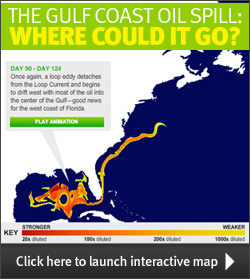Where Will All This Oil Be in August?
Slate's interactive models of the Deepwater Horizon spill.

As government officials continue to nervously monitor the cap on the Deepwater Horizon well, there are still millions of barrels of oil oozing around in the Gulf of Mexico. In order to minimize the damage, scientists, engineers, and government officials need to figure out where that oil is headed. The bad news: Few things on the planet are as unpredictable as the currents in the Gulf of Mexico.
While the spill is constantly being photographed both by satellite and aerial imagery, those pictures are incomplete. Because the source of the spill is so far beneath the waves, a great deal of the oil that's been spewed has never reached the surface.
This is where complex models of the gulf's currents and eddies come in handy. The National Center for Atmospheric Research has used 120 years of data to simulate how the gulf behaves. In order to determine where the oil from the BP spill might end up, the NCAR inserted a "virtual dye"—essentially, digital food coloring—into their enormously complex three-dimensional models. The result: lots and lots of oil-spill scenarios.
Synte Peacock, who led the modeling effort, provided Slate with data from three of NCAR's scenarios, which are displayed below. These three visualizations begin immediately after the spill and stop after the oil has been swimming around for 130 days or more. While it may seem strange to look at a simulation of the oil spill's past behavior, it's worth remembering that NCAR's 3-D models go well beyond our limited knowledge of what's really happening in the Gulf of Mexico. In particular, they can show what might happen to oil—or at least virtual oil—that flows beneath the water's surface.
What's most noteworthy about these simulations? In the more than 20 scenarios the scientists conducted, the dye never stayed entirely in the Gulf of Mexico. (Two other modeling efforts reached similar conclusions.) If these models are to be believed, then the oil from the BP spill will reach the Atlantic at some point in the next several months, quite likely coating much of the coastline in the process. But there is also a distinct possibility that, depending on the whims of the eddies that form over the next few weeks, a good deal of the spill will remain in the center of the Gulf, drawn away from the Florida straits.
The following visualizations will pause at interesting moments in each scenario. While the descriptions refer to oil, the computer simulations model dye. The major consequence of that disparity is that NCAR doesn't model the biological degradation of oil, a factor that could affect how far the spill spreads. Also note that the view here is from 20 meters beneath the surface, which is a rough approximation for the footprint of the spill as it extends beneath the waves.